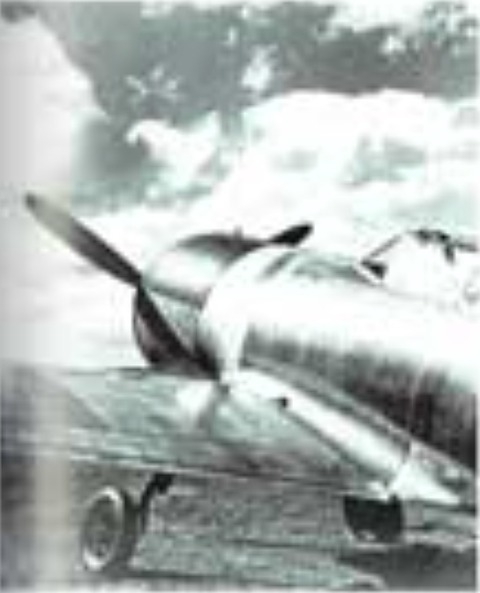blackkite
Don't laugh, don't cry, don't even curse, but.....
- Joined
- 31 May 2007
- Messages
- 8,819
- Reaction score
- 7,716
Hi!
Much of the information given here on the "Bf 109Z" is false, or at least highly distorted.
Many respected sources recount the twin-109F prototype that got bombed before it could fly (for example William Green's Warplanes of the Third Reich), but that now has to be cast in doubt.
According to Dan Sharp's research into original archive documents (Luftwaffe:Secret Designs of the Third Reich, Mortons, 2018. Pages 108-115), the relevant "schnellstbomber" programme began in May 1942. Several manufacturers submitted designs.
Messerschmitt first studied a composite Zwilling made from parts of several production types: 109 fuselages, 110 outer wings, Jumo 213 radial-engine power eggs. Many variations were subsequently considered in brief, some with 109 wings and/or other engines. Some even had a central 3-crew nacelle (depicted with rather loose imagination in an earlier post). Sharp does not note a big-gunned version, also posted earlier, and as this was a programme for a fast bomber, it seems highly unlikely. All retained twin production 109 tails.
They soon focused down onto Me 109 and 309 variants, wind tunnel tests resulting in the centre section being narrowed and the rear fuselages being joined by a single central tailplane fitted in place of the four conventional ones. The engines reverted to the 109's traditional inline.
A production design eventually emerged as the Me 109Zw (NB no longer Bf, due presumably to changes in the design office), based on two 109G airframes with a new centre section and the main undercarriage moved a little closer in towards the centreline of each fuselage. But Messerschmitt lost the competition. The Me 109Zw was dropped early in 1943, in favour of what became the Dornier Do 335 Pfeil. Subsequently, it was referred to as the Me 109Z.
Throughout, the competition phase was a paper exercise. Sharp documents it intimately. There is no discussion of an interim 109F based prototype. According to the many other respected authors, this would have been under construction throughout the period of the schnellstbomber competition. But it makes no sense; why would Messerschmitt be pursuing a direct parallel path for almost a year without it ever being mentioned in meeting after meeting? This would not be the first time we have caught the mainstream authors swallowing an unsubstantiated tall story, so on balance I believe that the 109F based prototype is a myth.

 en.wikipedia.org
en.wikipedia.org
Thank you very much!Here
Hi, an explanation of why "Bf" and later "Me" designations :
"Bayerische Flugzeugwerke (BFW) (Bavarian Aircraft Works) was reformed in 1926, in Augsburg, Bavaria, when Udet Flugzeugbau GmbH was changed into a joint-stock company. In the early stages, BMW AG held a stake in this company and was represented by Josef Popp, who held a place on the Supervisory Board.[2]
Willy Messerschmitt joined the company in 1927 as chief designer and engineer and formed a design team.
One of the first designs, the Messerschmitt M20, was a near-catastrophe for the designer and the company. Many[citation needed] of the prototypes crashed, one of them killing Hans Hackmack, a close friend of Erhard Milch, the head of Deutsche Luft Hansa and the German civil aviation authorities. Milch was upset by the lack of response from Messerschmitt and this led to a lifelong hatred towards him. Milch eventually cancelled all contracts with Messerschmitt and forced BFW into bankruptcy in 1931. However, Messerschmitt's friendship with Hugo Junkers prevented a stagnation of the careers of him and BFW, which was started again in 1933. Milch still prevented Messerschmitt's takeover of the BFW until 1938, hence the designation "Bf" of early Messerschmitt designs."
Hi, an explanation of why "Bf" and later "Me" designations :
"Bayerische Flugzeugwerke (BFW) (Bavarian Aircraft Works) was reformed in 1926, in Augsburg, Bavaria, when Udet Flugzeugbau GmbH was changed into a joint-stock company. In the early stages, BMW AG held a stake in this company and was represented by Josef Popp, who held a place on the Supervisory Board.[2]
Willy Messerschmitt joined the company in 1927 as chief designer and engineer and formed a design team.
One of the first designs, the Messerschmitt M20, was a near-catastrophe for the designer and the company. Many[citation needed] of the prototypes crashed, one of them killing Hans Hackmack, a close friend of Erhard Milch, the head of Deutsche Luft Hansa and the German civil aviation authorities. Milch was upset by the lack of response from Messerschmitt and this led to a lifelong hatred towards him. Milch eventually cancelled all contracts with Messerschmitt and forced BFW into bankruptcy in 1931. However, Messerschmitt's friendship with Hugo Junkers prevented a stagnation of the careers of him and BFW, which was started again in 1933. Milch still prevented Messerschmitt's takeover of the BFW until 1938, hence the designation "Bf" of early Messerschmitt designs."
A few things to mention about this. Firstly, I think Milch's relationship with Messerschmitt is much more complex than 'lifelong hatred'. Messerschmitt was invited to attend, and did attend, numerous GL meetings presided over by Milch from 1942 to 1944 - more than any other aircraft company representative with the possible exception of Hertel. Some, such as Ernst Heinkel and Walter Blume, are never (as far as I can tell) invited to attend. Interactions between Milch and Messerschmitt are usually cordial and professional.
When something particularly bad happens to Willy Messerschmitt - e.g. the Me 210 situation - Milch reads out a letter from Goering on the subject and states that he is refraining from saying anything else. On other occasions, Milch makes remarks about being misled by Messerschmitt but this is a very common complaint. Goering makes it too.
There's an interesting contrast between two GL meetings in May 1944 when the issue of the Me 262 having to be built as a bomber is discussed. During the first meeting (without Messerschmitt present), the various representatives such as Knemeyer and Petersen sound almost panicked in describing the problems of kitting the 262 out with bombs - there's only one place on the aircraft where the bombs can be attached and that causes 1) severe CG issues and 2) the nosewheel undercarriage isn't strong enough for it. There's also a supply issue with the bomb rack fairings.
But during the following meeting, Willy Messerschmitt is present and very smoothly explains away all the difficulties. He sounds very convincing - the CG issue isn't actually a problem because the fuel tanks only have to be moved a little to compensate, the nosewheel was already being strengthened so it's not a problem, the fairings are being sourced without issue etc.
This seems to happen quite often - Messerschmitt is very convincing when he speaks and nothing is ever his fault: it's the suppliers, the engines, the component manufacturers, the radiators etc. etc.
And it's evident that although Hitler knows very little about aircraft and very seldom interferes, Messerschmitt knows him personally and derives some sort of security or protection from that - more so than Milch.
So maybe Milch did hate him, but if he did he kept it well hidden and he doesn't seem to act against Messerschmitt during the course of the war.
On the subject of 'Me' versus 'Bf', for most of the war Messerschmitt's internal papers nearly always refer to the 'Me 109'. This is true of test and development reports, supply reports etc. as well as project drawings. So it's no surprise to see 'Me 109 Zw' in company documents. The 'official' designation was 'Bf 109', but colloquially it seems many people in Germany even outside Messerschmitt did also call it the 'Me 109', to the point where it was pretty much interchangable by the end of the war.
iirc, the supposed source of the animosity goes back to when Milch was in-charge of Luft Hansa. There was a Messerschmitt M.20 that crashed killing a good friend of Milch who then held Messerschmitts lack of action against him.
A new spin on the old "Me" vs "Bf" argument.
On the subject of 'Me' versus 'Bf', for most of the war Messerschmitt's internal papers nearly always refer to the 'Me 109'. This is true of test and development reports, supply reports etc. as well as project drawings. So it's no surprise to see 'Me 109 Zw' in company documents. The 'official' designation was 'Bf 109', but colloquially it seems many people in Germany even outside Messerschmitt did also call it the 'Me 109', to the point where it was pretty much interchangable by the end of the war.

I looked again and can't find it. The angle is slightly different from the existing Bf109V21 photos posted in this thread.There is already a 'high quality' version of that photo posted in this thread.
O suppose that might be affected by the level of manouvre predicted to be required.
Original drawing of Bf 109 V24do you have original drawing of the bf 109 V24 wing?


Some more photos in this video:High quality version of the Bf 109 V21 photo shown in my post above.
Thank you.Some more photos in this video:High quality version of the Bf 109 V21 photo shown in my post above.View: https://www.youtube.com/watch?v=KLtfabp9MYM
